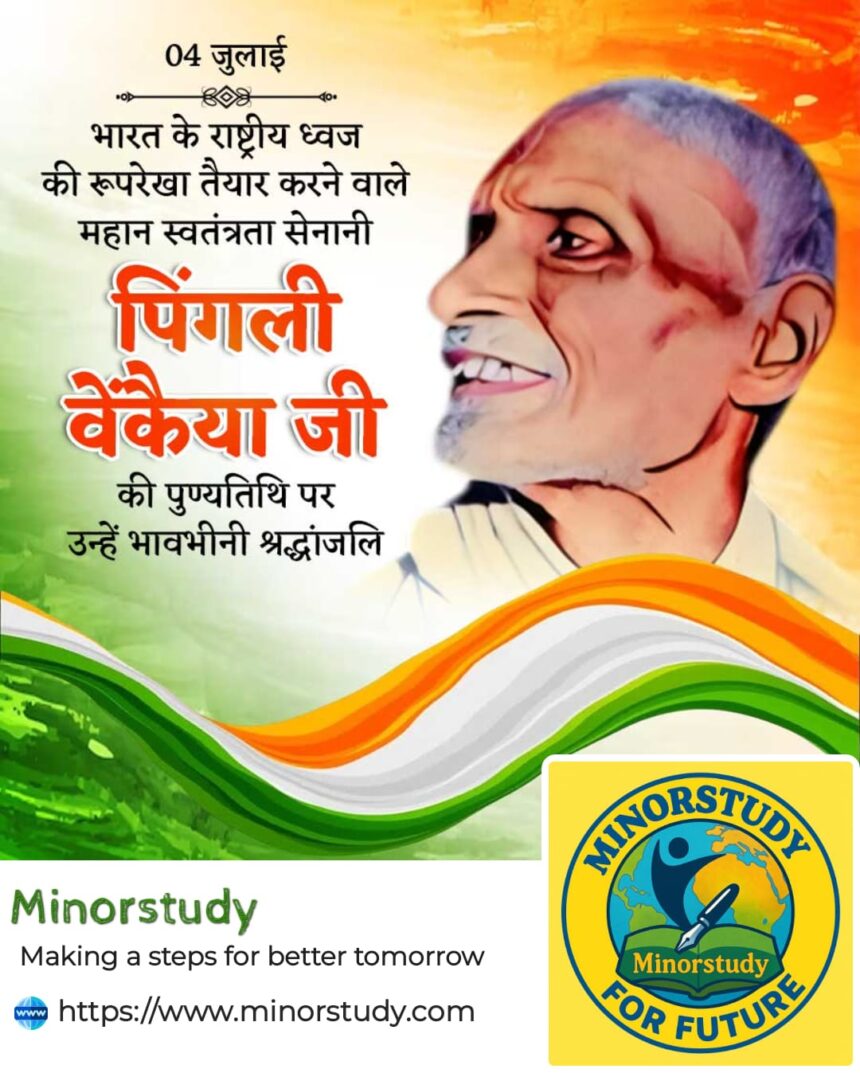11 Heroic Facts About Pingali Venkaiah – The Forgotten Genius Who Gave India Her Flag
Pingali Venkaiah: When we salute the Tiranga, India’s national flag, we pay silent homage to the sacrifices of our freedom fighters. But have you ever wondered who gave shape to this national symbol of pride? Behind every flutter of the tricolor lies the vision of a brilliant mind and a deeply patriotic heart—Mr. Pingali Venkaiah.
- 📜 Who Was Pingali Venkaiah?
- 📅 Timeline of Pingali Venkaiah’s Life
- 🏁 History of the Indian Flag & Venkaiah’s Role
- ✅ 11 Heroic Facts About Pingali Venkaiah
- 1. Designer of India’s First National Flag
- 2. A True Polymath
- 3. Served in British Army
- 4. Proposed 30 Flag Designs
- 5. Lived and Died in Obscurity
- 6. A Gandhian in True Spirit
- 7. Vision for Unity
- 8. Published a Book on Flag Philosophy
- 9. Ashoka Chakra Connection
- 10. Zero Recognition During His Lifetime
- 11. Posthumous Recognition Building
- 🌿 Significance in Modern India
- ❓ FAQs About Pingali Venkaiah
- Q1: Why is Pingali Venkaiah not widely known?
- Q2: Did Mahatma Gandhi approve of his flag?
- Q3: What was unique in his flag?
- Q4: Was his family given support?
- Q5: Is he given any national honor now?
- 🎉 Wishing and Remembering Pingali Venkaiah
- 📌 Important Points
- 🧭 Daily Life Impact of His Work
- 🧘 Conclusion: A Hero We Must Never Forget
Though not a household name like Nehru or Gandhi, Pingali Venkaiah’s contribution to India’s freedom and identity is monumental. His design of the Indian National Flag is not just cloth sewn together—it is a soulful representation of India’s unity, diversity, and freedom.
In this human-centric article, let’s dive deep into the history, facts, timeline, FAQs, significance, observance, and the daily life impact of this forgotten visionary. You’ll discover why Pingali Venkaiah deserves national reverence, and why his legacy is crucial even today.
📜 Who Was Pingali Venkaiah?
Pingali Venkaiah (born on 2 August 1876) was a freedom fighter, Gandhian, scholar, and designer of the Indian National Flag. He hailed from Bhatlapenumarru, near Machilipatnam in present-day Andhra Pradesh.
He was well-versed in multiple languages.
An agriculturist by profession, he also studied geology and Japanese.
Above all, he was a true patriot, working relentlessly for India’s independence and cultural identity.
📅 Timeline of Pingali Venkaiah’s Life
| Year | Milestone |
|---|---|
| 1876 | Born in Bhatlapenumarru, Andhra Pradesh |
| 1890s | Served in British Army in the Anglo-Boer War in South Africa |
| 1904 | Joined Indian National Congress and started actively participating in the freedom movement |
| 1916–1921 | Worked on multiple flag designs and researched symbolism |
| 1921 | Presented the national flag design to Mahatma Gandhi at a Congress session in Bezwada (now Vijayawada) |
| 1947 | His design evolved into the Indian National Flag adopted on 22 July 1947 |
| 1963 | Passed away in poverty and obscurity |
| 2009 | Andhra Pradesh Government recommended his name for Bharat Ratna |
| 2022 | Honored posthumously on his 146th birth anniversary during “Har Ghar Tiranga” celebrations |
🏁 History of the Indian Flag & Venkaiah’s Role
In 1921, at the Indian National Congress session in Bezwada, Pingali Venkaiah proposed a flag with two colors—red and green—representing Hindus and Muslims. Gandhiji suggested adding a white stripe for other communities and a spinning wheel (charkha) to symbolize self-reliance.
Over time, the design evolved into:
Three horizontal bands: saffron (courage), white (truth), and green (faith).
A navy blue Ashoka Chakra with 24 spokes in the center (added in 1947).
But the soul of the flag—its vision, inclusiveness, and message—came from Venkaiah’s design and dedication.
✅ 11 Heroic Facts About Pingali Venkaiah
1. Designer of India’s First National Flag
Pingali’s design laid the foundation of the tricolor we salute today. He is known as “Jhanda Venkaiah” in some circles.
2. A True Polymath
Apart from being a freedom fighter, he was a geologist, linguist, writer, and educationist. His depth of knowledge was rare and remarkable.
3. Served in British Army
He joined the British Army and fought in the Anglo-Boer War (South Africa). There, he met Mahatma Gandhi, which shaped his nationalist ideology.
4. Proposed 30 Flag Designs
Venkaiah was so passionate about the national flag that he created 30 different designs, which he compiled in his booklet titled “A National Flag for India” in 1916.
5. Lived and Died in Obscurity
Despite his massive contribution, he died in poverty in 1963, largely ignored by the government and society. His family continues to live in modest conditions.
6. A Gandhian in True Spirit
He believed in swadeshi, self-reliance, and simple living—values he incorporated into the flag and his lifestyle.
7. Vision for Unity
His original flag concept wasn’t about political symbolism—it was about communal harmony, national identity, and spiritual integrity.
8. Published a Book on Flag Philosophy
He published detailed notes on the meaning and need for a national flag—highlighting the importance of symbols in uniting people.
9. Ashoka Chakra Connection
Though the chakra was added later (from Emperor Ashoka’s pillar at Sarnath), Venkaiah’s idea of the charkha inspired this spiritual evolution of the flag.
10. Zero Recognition During His Lifetime
Despite being a national asset, he received no formal recognition, award, or pension during his lifetime. This remains one of the saddest oversights in India’s post-independence era.
11. Posthumous Recognition Building
Only in the 21st century, especially under the Azadi Ka Amrit Mahotsav campaign, has his legacy been publicly honored. His statues, stamps, and documentaries are now beginning to appear.
🌿 Significance in Modern India
Pingali Venkaiah represents the silent heroes of the independence movement.
His story reminds us that recognition should not be delayed until death.
The flag he designed is a living symbol of unity, courage, and pride.
His life is an example of selfless service to the nation—without seeking fame or fortune.
❓ FAQs About Pingali Venkaiah
Q1: Why is Pingali Venkaiah not widely known?
A: Sadly, his contributions were overlooked due to lack of political spotlight. In recent years, efforts have begun to restore his rightful place in history.
Q2: Did Mahatma Gandhi approve of his flag?
A: Yes. Gandhi was deeply impressed by his design and supported the idea of a symbolic flag for uniting India.
Q3: What was unique in his flag?
A: The charkha (spinning wheel) in the center reflected India’s economic self-reliance, inspired by Gandhi’s philosophy.
Q4: Was his family given support?
A: For decades, no. However, recent efforts have been made to recognize and assist his descendants.
Q5: Is he given any national honor now?
A: He has been honored through postage stamps, statues, and government acknowledgments, but not yet awarded the Bharat Ratna—India’s highest civilian award, which many believe he richly deserves.
🎉 Wishing and Remembering Pingali Venkaiah
“Let every flutter of the tricolor remind us of Pingali Venkaiah—the man who gave us not just a flag, but a soul-stirring symbol of freedom.”
“On every Independence Day, let’s salute this unsung hero and carry his legacy forward through respect, awareness, and national unity.”
“May his memory never fade, and may his values always shine in our hearts.”
📌 Important Points
Pingali Venkaiah is the father of the Indian National Flag.
His life teaches us patriotism, humility, and selfless devotion.
Honoring his legacy is not optional—it’s a national duty.
The Tiranga is not just fabric—it is his soul stitched into history.
🧭 Daily Life Impact of His Work
Every flag hoisting is a tribute to him.
His ideals of unity in diversity resonate in every Indian institution.
He shows that ideas matter as much as action—his design united millions.
His story inspires today’s youth to innovate, serve, and remain rooted in values.
🧘 Conclusion: A Hero We Must Never Forget
Pingali Venkaiah was not just a designer—he was a visionary patriot who helped India discover its symbol of identity. His name should be taught in schools, chanted in rallies, and remembered on every national holiday. His tricolor remains our compass, and his life our guiding flame.
Let us ensure that India never forgets the man who gifted her the soul-stirring identity she holds so proudly—a symbol not just of freedom, but of hope, strength, and unity.









Hiya, I am really glad I have found this info. Nowadays bloggers publish only about gossips and internet and this is actually annoying. A good website with exciting content, this is what I need. Thanks for keeping this web-site, I’ll be visiting it. Do you do newsletters? Cant find it.